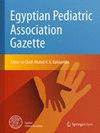Frequency of hepatitis C virus infection in patients with pediatric inflammatory bowel disease: a cross-sectional study
IF 0.5
Q4 PEDIATRICS
引用次数: 0
Abstract
Patients with pediatric inflammatory bowel disease (PIBD) are believed to be at higher risk of hepatitis C virus (HCV) infection not only due to using of immunosuppressive drugs but also because of repeated blood transfusion and endoscopic and other invasive procedures used for diagnoses and effective controlling of the disease, so this study aimed to assess the frequency of HCV infection, in patients with PIBD at the New Children’s Hospital, Cairo University, and identify the potential risk factors. This cross-sectional analytic study included 165 IBD patients between 1 and 16 years old of both sexes who were attending the Pediatric Gastroenterology Clinic in the New Children’s University Hospital, Cairo University. All patients were screened for anti-HCV antibodies using ELISA. Factors related to IBD (severity, modalities of the treatment, and invasive procedures), to infection (blood transfusion history and family history of hepatitis), and liver enzymes were registered. The risk factors were evaluated by multivariate logistic regression analysis. Present and/or past HCV infection was found in five (3%) of the IBD patients. The multivariate logistic regression to detect independent predictors of HCV +ve antibodies patients had statistically significant value with number of hospital admission related to IBD with p-value = 0.002, odd ratio (OR) = 1.467, and confidence interval (CI) = 95% (1.145–1.879) and with number of hospital admission unrelated to IBD with p-value = 0.024, OR = 0.750, and CI 95% (0.585–0.963). The frequency of HCV infection in PIBD patients was 3%. Thus, the frequency of HCV infection in PIBD patients is similar to that in the normal population of the developing countries, and it is strongly related to hospital admission due to IBD or non-IBD causes.儿童炎症性肠病患者丙型肝炎病毒感染的频率:一项横断面研究
儿童炎症性肠病(PIBD)患者感染丙型肝炎病毒(HCV)的风险较高,这不仅是因为使用免疫抑制药物,还因为反复输血、内镜和其他侵入性手术用于诊断和有效控制疾病,因此本研究旨在评估开罗大学新儿童医院PIBD患者感染丙型肝炎病毒的频率。并确定潜在的风险因素。这项横断面分析研究包括165名在开罗大学新儿童大学医院儿科胃肠病学诊所就诊的1至16岁男女IBD患者。所有患者均采用ELISA法筛查抗hcv抗体。记录了与IBD(严重程度、治疗方式和侵入性手术)、感染(输血史和肝炎家族史)和肝酶相关的因素。采用多因素logistic回归分析评价危险因素。5例(3%)IBD患者存在和/或既往HCV感染。多因素logistic回归检测HCV +ve抗体患者独立预测因子,与IBD相关的住院次数(p值= 0.002,奇比(OR) = 1.467,置信区间(CI) = 95%(1.145 ~ 1.879),与IBD无关的住院次数(p值= 0.024,OR = 0.750, CI 95%(0.585 ~ 0.963),具有统计学意义。PIBD患者HCV感染的发生率为3%。由此可见,发展中国家PIBD患者中HCV感染的频率与正常人群相似,且与因IBD或非IBD原因住院密切相关。
本文章由计算机程序翻译,如有差异,请以英文原文为准。
求助全文
约1分钟内获得全文
求助全文
来源期刊

Egyptian Pediatric Association Gazette
PEDIATRICS-
自引率
0.00%
发文量
32
审稿时长
9 weeks
期刊介绍:
The Gazette is the official journal of the Egyptian Pediatric Association. The main purpose of the Gazette is to provide a place for the publication of high-quality papers documenting recent advances and new developments in both pediatrics and pediatric surgery in clinical and experimental settings. An equally important purpose of the Gazette is to publish local and regional issues related to children and child care. The Gazette welcomes original papers, review articles, case reports and short communications as well as short technical reports. Papers submitted to the Gazette are peer-reviewed by a large review board. The Gazette also offers CME quizzes, credits for which can be claimed from either the EPA website or the EPA headquarters. Fields of interest: all aspects of pediatrics, pediatric surgery, child health and child care. The Gazette complies with the Uniform Requirements for Manuscripts submitted to biomedical journals as recommended by the International Committee of Medical Journal Editors (ICMJE).
 求助内容:
求助内容: 应助结果提醒方式:
应助结果提醒方式:


